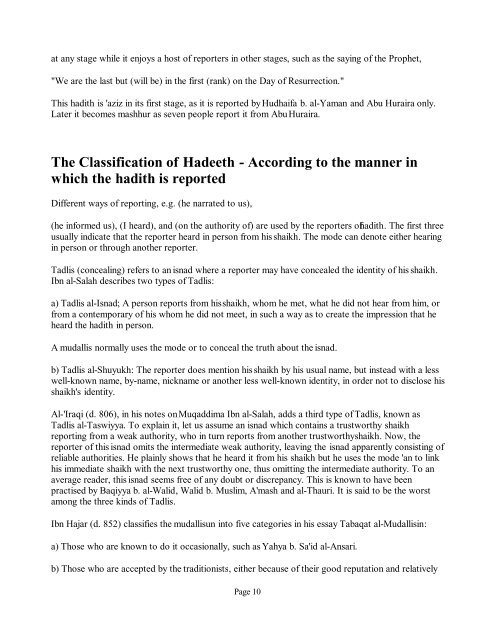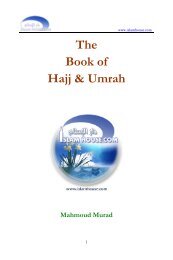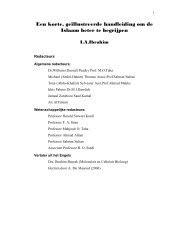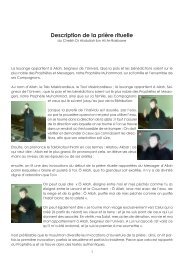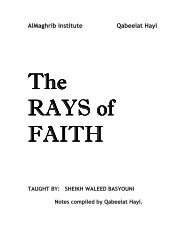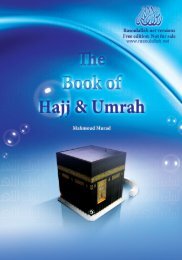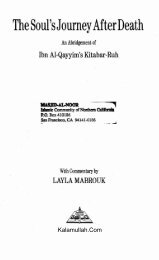Rules Governing The Criticism Of Hadith - Islam House
Rules Governing The Criticism Of Hadith - Islam House
Rules Governing The Criticism Of Hadith - Islam House
You also want an ePaper? Increase the reach of your titles
YUMPU automatically turns print PDFs into web optimized ePapers that Google loves.
at any stage while it enjoys a host of reporters in other stages, such as the saying of the Prophet,<br />
"We are the last but (will be) in the first (rank) on the Day of Resurrection."<br />
This hadith is 'aziz in its first stage, as it is reported by Hudhaifa b. al-Yaman and Abu Huraira only.<br />
Later it becomes mashhur as seven people report it from Abu Huraira.<br />
<strong>The</strong> Classification of Hadeeth - According to the manner in<br />
which the hadith is reported<br />
Different ways of reporting, e.g. (he narrated to us),<br />
(he informed us), (I heard), and (on the authority of) are used by the reporters of hadith. <strong>The</strong> first three<br />
usually indicate that the reporter heard in person from his shaikh. <strong>The</strong> mode can denote either hearing<br />
in person or through another reporter.<br />
Tadlis (concealing) refers to an isnad where a reporter may have concealed the identity of his shaikh.<br />
Ibn al-Salah describes two types of Tadlis:<br />
a) Tadlis al-Isnad; A person reports from his shaikh, whom he met, what he did not hear from him, or<br />
from a contemporary of his whom he did not meet, in such a way as to create the impression that he<br />
heard the hadith in person.<br />
A mudallis normally uses the mode or to conceal the truth about the isnad.<br />
b) Tadlis al-Shuyukh: <strong>The</strong> reporter does mention his shaikh by his usual name, but instead with a less<br />
well-known name, by-name, nickname or another less well-known identity, in order not to disclose his<br />
shaikh's identity.<br />
Al-'Iraqi (d. 806), in his notes on Muqaddima Ibn al-Salah, adds a third type of Tadlis, known as<br />
Tadlis al-Taswiyya. To explain it, let us assume an isnad which contains a trustworthy shaikh<br />
reporting from a weak authority, who in turn reports from another trustworthy shaikh. Now, the<br />
reporter of this isnad omits the intermediate weak authority, leaving the isnad apparently consisting of<br />
reliable authorities. He plainly shows that he heard it from his shaikh but he uses the mode 'an to link<br />
his immediate shaikh with the next trustworthy one, thus omitting the intermediate authority. To an<br />
average reader, this isnad seems free of any doubt or discrepancy. This is known to have been<br />
practised by Baqiyya b. al-Walid, Walid b. Muslim, A'mash and al-Thauri. It is said to be the worst<br />
among the three kinds of Tadlis.<br />
Ibn Hajar (d. 852) classifies the mudallisun into five categories in his essay Tabaqat al-Mudallisin:<br />
a) Those who are known to do it occasionally, such as Yahya b. Sa'id al-Ansari.<br />
b) Those who are accepted by the traditionists, either because of their good reputation and relatively<br />
Page 10


